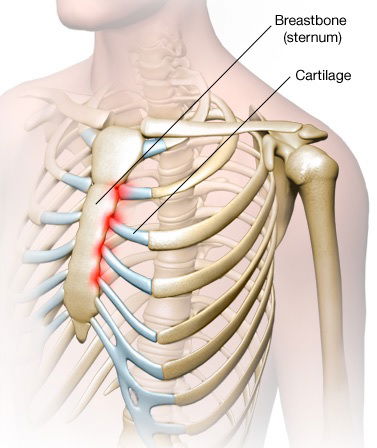Tietze Syndrome : Not All Chest Pain are Heart Attack !
Doctor, My Chest is Paining, am I having a Heart Attack?
See, Chest Pain if it occurs especially on Left Side and you feel the pain going to the Shoulder as well as the arm should be taken seriously but most Chest Pains are Non-Heart origin types. Here we will discuss of a common but often missed condition causing Chest Pain called Tietze Syndrome.
What is Tietze Syndrome?
It is a benign (Not Harmful ) cause of Chest Pain which generally is felt in 1st to 4th rib ( More common in 2nd and 3rd Rib) at a place where your Ribs meet the Breast Bone ( sternum).
Generally, we see signs of Inflammation at the place of Pain,( like Redness or Swelling.)

Why is it Called Tietze Syndrome?
Because it was first described in 1921 by German Surgeon Alexander Tietze !! and hence is the reason for the Name.
So what are the causes of it?
Like most Diseases, even its cause is unclear.
It is thought to be caused by repeated Micro or small trauma to the chest wall and sometimes various underlying Arthritis may also be the causative agent.
Metabolic causes like Diabetes or thyroid problems are notorious for causing it.
Excessive vomiting, coughing, and trauma to Chest may also cause it.
What are the Symptoms of this disease?
- Generally, Patients present with Acute Chest Pain mainly at the 2nd and 3rd Rib areas, where your Ribs meet the Sternum.
- There is occasionally, redness and swelling over the area.
- Pain is sharp and stabbing in nature ( feels like Injury by a sharp object).
- Pain Increases with Movements, coughing, Sneezing, or activity.
How to Diagnose Tietze Syndrome?
There are no definitive tests to diagnose this disease.
Clinical signs and symptoms are the main features of the diagnosis.
Your doctor may give you blood tests like CBC ESR CRP to see signs of inflammation.
Ultrasonography tests can be very good to see signs of inflammation over the affected area.
In very difficult cases, Your doctor may prescribe you a CT Scan or MRI so that a definite diagnosis can be made.
In most cases, an ECG is done if the pain is on the Left side of the Chest to rule out Heart-related causes.

What are the Treatments available?
In most cases, it Heals on its Own !! ( Self-Limiting). And it doesn't recur.
If the Pain is severe and affects your Daily routine your doctor will add Pain Killers with Anti Inflammatory Drugs for Few Days.
Applying warmth to the area helps in soothing the pain.
If the Pain doesn't improve, with help of ultrasonography guidance local steroid injections may be given over the area to reduce inflammation and Pain.
In the rarest of rare cases, Surgery may be needed where the rib is resected out.
Exercises: Deep Breathing exercises and general stretching exercises are quite helpful.
Is it the Same as Costochondritis?
There are Some differences, in Costochondritis there is NO definitive swelling or Redness over the area, and in Costochondritis the involved ribs are from 2nd to 5th.
Ultrasonography doesn't show any features in costochondritis.
Kindly leave back any doubts or Suggestions in the comment box below.